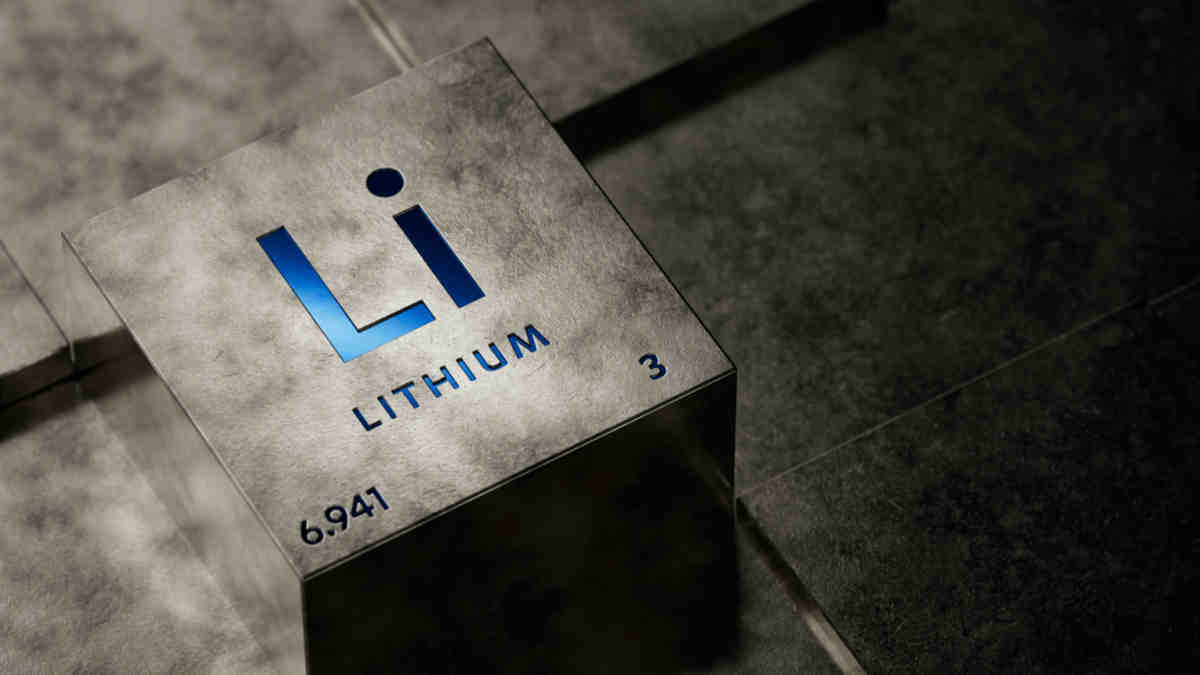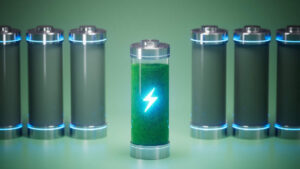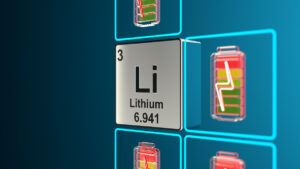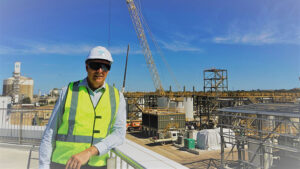Hot Money Monday: Could lithium metal batteries be the spark investors need?

Lithium metal batteries could change the game. Pic: Getty Images
- Lithium metal batteries could boost EV range
- Dendrites a big hurdle for lithium tech right now
- Solid-state batteries lead the lithium race
Right now, lithium-ion batteries are the go-to for most electric vehicles, but there’s a limitation: they use graphite anodes, which limits the battery’s energy density.
And energy density is everything, especially when it comes to EVs. If you want to improve vehicle range, you need more energy packed into each cell.
Current generation EVs are reaching around 400km in range, but imagine improving that by 50% or more. That’s exactly what lithium metal batteries could do.
“Lithium metal anodes offer the highest gravimetric energy density possible of any anode for batteries based on lithium-ion chemistry,” said Daniel Parr, a technology analyst at tech consultancy firm, IDTechEx.
“As such, they have been a primary target for commercialisation efforts.”
But, of course, there’s a catch.
Parr explained that lithium metal is plated and stripped from the anode current collector through charging and discharging.
But inhomogeneous plating leads to tendril-like formations on the surface of the current collector, which are known as lithium dendrites.
These are basically tiny tendril-like structures that form on the anode.
Unfortunately, they can grow and pierce the solid electrolyte interface (SEI) layer and react with the electrolyte. And that leads to a series of problems like losing active material.
“Over time, they can also limit battery lifetime and lead to early cell failure. Short circuits can also occur if the dendrites reach the cathode layer, rendering the battery useless.”
“So at the moment, lithium dendrites are the major failure mechanism.”
So what can we do about dendrites?
With this issue in play, the development of lithium metal batteries has been slow. But there’s hope.
Researchers and companies are working on solutions, like using separators.
“Separators can be used to prevent dendrites from reaching the electrolyte and regulate ion deposition and transfer through special coatings,” Parr explained.
“Alternatively, a solid-state electrolyte can serve the same purpose, though it may limit interface conductivity.”
Another solution could be optimising the temperature and pressure at which lithium metal plating and stripping happens, but that comes with its own set of challenges.
And then there’s the slow charging vs fast discharging issue.
Lithium metal batteries can perform better at slow charging, but electric vehicle owners want fast charging.
Finding that balance, therefore, is key if this technology is to be adopted on a mass scale.
Solid-state battery leads race
There are three main types of lithium metal batteries that are getting attention right now:
- Solid-state,
- Liquid electrolyte; and
- Lithium-sulphur.
One of the major advantages of a solid-state battery system is the ability to enable lithium metal anodes.
“As such, many solid-state battery developers are expected to move towards lithium metal, with some already having successful products,” Parr says.
On the other hand, liquid electrolyte lithium metal batteries have been slower to develop due to the dendrite issue.
But if developers can overcome that, these batteries might offer higher energy storage.
“Lithium metal batteries with liquid electrolytes have experienced slower development due to the challenge of lithium dendrites.
“But once developed, they are expected to offer higher specific energy, as well as potentially taking advantage of existing battery production infrastructure, which could reduce costs.”
Lastly, lithium-sulphur batteries use a sulphur cathode instead of the traditional NMC or LFP cathodes, offering higher energy density.
But they come with their own challenge: a phenomenon called ‘polysulfide shuttle’, which limits their lifespan.
“Lithium-sulfur is the final lithium metal battery of interest, differentiated using a sulfur cathode rather than incumbent cathode technology (NMC and LFP),” Parr notes.
“It offers higher gravimetric energy density, but an additional failure mechanism in the form of polysulfide shuttle.
“As such, its development is slow, and overall lifetime is expected to be even more limited than other lithium metal technologies.”
Lithium metal battery market could explode
Now, while lithium metal batteries are facing hurdles, their high energy density makes them perfect for high-demand applications like aviation, maritime, and defence.
These industries prioritise gravimetric energy density, and lithium metal batteries could offer the performance boost they need.
However, these markets are much smaller than the EV sector, meaning the biggest demand will likely come from EVs.
“Electric vehicles are expected to be the largest source of demand, and most lithium metal battery developers are focusing on this market.”
Looking at the big picture, Parr said: “Lithium metal batteries are well placed to see significant adoption in the next ten years.”
The mass production of solid-state lithium metal batteries is expected to kick off around 2027/2028, with liquid electrolyte versions and lithium-sulphur batteries following soon after.
“Solid-state lithium metal, meanwhile, is expected to remain the dominant market proportion throughout this period, making up over 70% of the total market by 2035.”
So, what’s the bottom line?
By 2035, the lithium metal battery market is expected to exceed US$13 billion, and with EVs leading the charge, there’s a lot of momentum building.
It’s a space to watch as the new tech starts to mature, Parr said.
Now read: How close are we to the lithium revival?
Lithium and battery tech-related stocks on the ASX
| Security | Description | Last | %Mth | %6-Mth | %Yr | MktCap |
|---|---|---|---|---|---|---|
| XTC | XTC Lithium Limited | 0.200 | 19900% | 19900% | 19900% | $17,528,272 |
| LRV | Larvottoresources | 0.870 | 38% | 164% | 1303% | $356,181,654 |
| MHK | Metalhawk. | 0.340 | -7% | 270% | 353% | $38,607,076 |
| ASL | Andean Silver | 1.155 | 12% | 52% | 344% | $183,383,687 |
| OBM | Ora Banda Mining Ltd | 0.940 | 31% | 83% | 284% | $1,767,969,979 |
| ARN | Aldoro Resources | 0.350 | 25% | 349% | 250% | $60,603,810 |
| JBY | James Bay Minerals | 0.540 | 3% | 440% | 192% | $38,804,816 |
| ICL | Iceni Gold | 0.085 | 15% | 113% | 136% | $26,170,266 |
| MXR | Maximus Resources | 0.068 | 10% | 127% | 132% | $29,157,563 |
| SRZ | Stellar Resources | 0.015 | 15% | -21% | 114% | $31,196,259 |
| EMC | Everest Metals Corp | 0.165 | 14% | 32% | 104% | $36,924,333 |
| EMC | Everest Metals Corp | 0.165 | 14% | 32% | 104% | $36,924,333 |
| VUL | Vulcan Energy | 4.200 | -25% | 8% | 103% | $952,977,712 |
| CY5 | Cygnus Metals Ltd | 0.135 | 4% | 133% | 101% | $114,646,276 |
| MTM | MTM Critical Metals | 0.190 | -22% | 211% | 94% | $87,083,254 |
| PEC | Perpetual Res Ltd | 0.018 | 13% | 80% | 80% | $14,874,262 |
| ZEO | Zeotech Limited | 0.052 | 6% | 49% | 79% | $96,394,293 |
| AUN | Aurumin | 0.065 | 2% | 81% | 71% | $32,126,909 |
| FTL | Firetail Resources | 0.073 | -3% | 11% | 63% | $27,742,042 |
| QPM | QPM Energy Limited | 0.063 | -3% | 110% | 62% | $158,840,371 |
| SGQ | St George Min Ltd | 0.032 | 19% | -6% | 60% | $39,633,294 |
| DYM | Dynamicmetalslimited | 0.285 | -2% | 84% | 58% | $13,960,725 |
| KAI | Kairos Minerals Ltd | 0.022 | 57% | 120% | 57% | $57,880,068 |
| MM1 | Midasmineralsltd | 0.140 | 75% | 130% | 56% | $17,378,155 |
| OZM | Ozaurum Resources | 0.110 | 255% | 108% | 51% | $21,722,456 |
| ADG | Adelong Gold Limited | 0.006 | 20% | 50% | 50% | $8,384,917 |
| LM1 | Leeuwin Metals Ltd | 0.125 | 4% | 56% | 42% | $7,836,407 |
| RON | Ronin Resources | 0.175 | -13% | 82% | 40% | $7,065,627 |
| LTM | Arcadium Lithium PLC | 9.090 | 0% | 121% | 28% | $2,083,182,221 |
| PSC | Prospect Res Ltd | 0.095 | -4% | -10% | 27% | $54,402,983 |
| NAE | New Age Exploration | 0.005 | 67% | 43% | 25% | $10,781,995 |
| DVP | Develop Global Ltd | 2.940 | 22% | 38% | 25% | $798,520,626 |
| L1M | Lightning Minerals | 0.088 | 2% | 10% | 24% | $9,092,892 |
| WCN | White Cliff Min Ltd | 0.020 | -3% | 30% | 22% | $36,961,680 |
| WES | Wesfarmers Limited | 76.120 | 4% | 2% | 19% | $88,044,756,041 |
| INR | Ioneer Ltd | 0.160 | -24% | 23% | 19% | $376,907,603 |
| NVA | Nova Minerals Ltd | 0.320 | -4% | 94% | 19% | $103,032,773 |
| SCN | Scorpion Minerals | 0.021 | 5% | 40% | 17% | $8,598,580 |
| SCN | Scorpion Minerals | 0.021 | 5% | 40% | 17% | $8,598,580 |
| ALY | Alchemy Resource Ltd | 0.009 | 29% | 50% | 13% | $10,602,686 |
| SUM | Summitminerals | 0.087 | -38% | -60% | 12% | $7,580,135 |
| PLN | Pioneer Lithium | 0.200 | -7% | 18% | 11% | $7,662,337 |
| DAL | Dalaroometalsltd | 0.021 | 17% | 5% | 5% | $5,215,875 |
| ENT | Enterprise Metals | 0.003 | 0% | 0% | 0% | $2,356,635 |
| MNS | Magnis Energy Tech | 0.042 | 0% | 0% | 0% | $50,378,922 |
| LLL | Leolithiumlimited | 0.333 | 0% | 0% | 0% | $401,057,170 |
| ENT | Enterprise Metals | 0.003 | 0% | 0% | 0% | $2,356,635 |
| RIO | Rio Tinto Limited | 123.490 | 2% | 10% | -2% | $44,579,355,139 |
| ADV | Ardiden Ltd | 0.155 | 11% | 29% | -6% | $9,690,213 |
| VMC | Venus Metals Cor Ltd | 0.089 | 35% | 46% | -7% | $17,455,453 |
| RAS | Ragusa Minerals Ltd | 0.023 | 92% | 44% | -8% | $3,279,772 |
| TMX | Terrain Minerals | 0.005 | 13% | 50% | -10% | $9,016,005 |
| GSM | Golden State Mining | 0.010 | 19% | -21% | -14% | $2,654,021 |
| LEL | Lithenergy | 0.370 | 0% | 12% | -14% | $41,440,581 |
| RAG | Ragnar Metals Ltd | 0.018 | -5% | -14% | -14% | $8,531,748 |
| IPT | Impact Minerals | 0.010 | -9% | -23% | -17% | $30,594,337 |
| G88 | Golden Mile Res Ltd | 0.010 | 43% | 11% | -17% | $5,273,479 |
| EPM | Eclipse Metals | 0.006 | -14% | -5% | -17% | $14,299,095 |
| LIS | Lisenergylimited | 0.125 | -4% | -7% | -17% | $80,025,029 |
| SLM | Solismineralsltd | 0.100 | 33% | -9% | -17% | $7,699,883 |
| TEM | Tempest Minerals | 0.006 | 10% | -39% | -18% | $3,489,914 |
| AEV | Avenira Limited | 0.008 | 0% | -27% | -20% | $25,421,152 |
| SMX | Strata Minerals | 0.034 | 3% | 55% | -21% | $7,939,644 |
| A8G | Australasian Metals | 0.069 | -14% | -31% | -22% | $3,994,391 |
| KZR | Kalamazoo Resources | 0.078 | 0% | 0% | -22% | $16,620,974 |
| RLC | Reedy Lagoon Corp. | 0.003 | 50% | 0% | -25% | $2,330,120 |
| CTN | Catalina Resources | 0.003 | 0% | 20% | -25% | $3,948,786 |
| VKA | Viking Mines Ltd | 0.009 | 0% | 29% | -25% | $11,953,326 |
| DRE | Dreadnought | 0.015 | 25% | -21% | -25% | $62,388,000 |
| ASN | Anson Resources Ltd | 0.064 | 0% | -33% | -26% | $88,751,138 |
| EG1 | Evergreenlithium | 0.080 | 5% | 74% | -27% | $4,385,940 |
| MLS | Metals Australia | 0.021 | -13% | 5% | -28% | $15,303,110 |
| YAR | Yari Minerals Ltd | 0.005 | 67% | 25% | -29% | $2,411,789 |
| DAF | Discovery Alaska Ltd | 0.014 | -30% | 40% | -30% | $3,279,286 |
| BUR | Burleyminerals | 0.049 | -41% | -57% | -31% | $7,368,176 |
| FRS | Forrestaniaresources | 0.015 | 50% | -32% | -32% | $3,936,817 |
| OCT | Octava Minerals | 0.040 | -69% | -9% | -32% | $2,440,372 |
| BMM | Bayanminingandmin | 0.050 | 0% | 11% | -32% | $4,809,472 |
| HWK | Hawk Resources. | 0.024 | 4% | -10% | -33% | $5,710,307 |
| AAJ | Aruma Resources Ltd | 0.010 | 0% | -29% | -33% | $2,220,582 |
| AOA | Ausmon Resorces | 0.002 | 33% | 0% | -33% | $2,179,455 |
| VSR | Voltaic Strategic | 0.012 | -8% | -8% | -33% | $6,810,603 |
| STM | Sunstone Metals Ltd | 0.007 | 0% | -30% | -36% | $36,050,025 |
| IGO | IGO Limited | 4.480 | -17% | -15% | -37% | $3,498,577,296 |
| AML | Aeon Metals Ltd. | 0.005 | 0% | 0% | -38% | $5,482,003 |
| KTA | Krakatoa Resources | 0.010 | 0% | 11% | -38% | $5,901,340 |
| MRR | Minrex Resources Ltd | 0.008 | -11% | -6% | -38% | $8,678,940 |
| TKM | Trek Metals Ltd | 0.025 | 0% | -39% | -39% | $13,043,072 |
| TOR | Torque Met | 0.105 | 106% | 0% | -40% | $28,314,712 |
| TOR | Torque Met | 0.105 | 106% | 0% | -40% | $28,314,712 |
| ASR | Asra Minerals Ltd | 0.003 | 0% | -50% | -40% | $6,937,890 |
| EUR | European Lithium Ltd | 0.051 | -36% | 38% | -41% | $73,704,255 |
| PLL | Piedmont Lithium Inc | 0.130 | -4% | 4% | -41% | $81,478,514 |
| MAN | Mandrake Res Ltd | 0.022 | 0% | -21% | -42% | $13,799,718 |
| ATC | Altech Batt Ltd | 0.046 | 5% | 15% | -42% | $92,116,676 |
| FG1 | Flynngold | 0.026 | 0% | 8% | -43% | $6,794,228 |
| AZI | Altamin Limited | 0.026 | 18% | -18% | -43% | $14,937,075 |
| PLS | Pilbara Min Ltd | 2.080 | -15% | -29% | -43% | $6,822,011,613 |
| DLI | Delta Lithium | 0.175 | -3% | -20% | -44% | $125,394,814 |
| BNR | Bulletin Res Ltd | 0.046 | 24% | -2% | -44% | $13,506,213 |
| RGL | Riversgold | 0.005 | 43% | 0% | -44% | $8,418,563 |
| OCN | Oceanalithiumlimited | 0.027 | 0% | -1% | -44% | $3,712,402 |
| SRI | Sipa Resources Ltd | 0.012 | -8% | -20% | -45% | $4,996,780 |
| LTR | Liontown Resources | 0.615 | -13% | -27% | -46% | $1,529,305,302 |
| THR | Thor Energy PLC | 0.014 | 17% | -7% | -46% | $3,756,065 |
| HAW | Hawthorn Resources | 0.044 | 5% | -28% | -46% | $14,740,687 |
| KGD | Kula Gold Limited | 0.005 | 25% | -41% | -47% | $3,548,268 |
| NMT | Neometals Ltd | 0.073 | -8% | -14% | -48% | $56,168,031 |
| RMX | Red Mount Min Ltd | 0.009 | 0% | -40% | -49% | $4,184,620 |
| PAT | Patriot Lithium | 0.046 | 0% | 0% | -49% | $5,815,226 |
| ADO | Anteotech Ltd | 0.016 | 0% | -23% | -50% | $43,284,805 |
| EVR | Ev Resources Ltd | 0.006 | 200% | 45% | -50% | $11,595,020 |
| TKL | Traka Resources | 0.001 | 0% | -33% | -50% | $2,125,790 |
| BYH | Bryah Resources Ltd | 0.004 | 0% | 0% | -50% | $2,507,203 |
| OB1 | Orbminco Limited | 0.002 | 0% | -33% | -50% | $4,333,180 |
| MQR | Marquee Resource Ltd | 0.011 | -8% | -15% | -50% | $5,340,285 |
| TYX | Tyranna Res Ltd | 0.007 | 75% | 40% | -50% | $23,015,477 |
| LNR | Lanthanein Resources | 0.003 | 20% | 0% | -50% | $7,330,908 |
| FIN | FIN Resources Ltd | 0.007 | 75% | 17% | -50% | $4,544,881 |
| ANX | Anax Metals Ltd | 0.010 | -9% | -47% | -50% | $9,640,969 |
| KNG | Kingsland Minerals | 0.115 | 0% | -36% | -50% | $8,344,505 |
| PNN | Power Minerals Ltd | 0.083 | -10% | -5% | -51% | $9,449,954 |
| PL3 | Patagonia Lithium | 0.073 | -13% | 0% | -51% | $4,774,255 |
| LIT | Livium Ltd | 0.014 | -13% | -33% | -52% | $18,860,195 |
| GW1 | Greenwing Resources | 0.035 | -20% | -30% | -52% | $8,422,802 |
| BM8 | Battery Age Minerals | 0.076 | -16% | -44% | -53% | $9,053,944 |
| PGD | Peregrine Gold | 0.125 | -7% | -38% | -53% | $9,932,996 |
| CMD | Cassius Mining Ltd | 0.015 | 0% | 150% | -53% | $9,630,667 |
| A11 | Atlantic Lithium | 0.185 | -27% | -35% | -53% | $128,232,253 |
| DTM | Dart Mining NL | 0.006 | -40% | -59% | -53% | $3,588,333 |
| MIN | Mineral Resources. | 27.130 | -26% | -41% | -54% | $5,076,075,541 |
| LU7 | Lithium Universe Ltd | 0.010 | 11% | -28% | -54% | $7,859,796 |
| LRD | Lordresourceslimited | 0.024 | 14% | -4% | -54% | $1,858,224 |
| LRD | Lordresourceslimited | 0.024 | 14% | -4% | -54% | $1,858,224 |
| LRD | Lordresourceslimited | 0.024 | 14% | -4% | -54% | $1,858,224 |
| OLY | Olympio Metals Ltd | 0.040 | 14% | 8% | -55% | $3,479,059 |
| ZNC | Zenith Minerals Ltd | 0.042 | 0% | -5% | -56% | $17,112,540 |
| BTM | Breakthrough Minsltd | 0.073 | -8% | -56% | -56% | $3,493,743 |
| CHR | Charger Metals | 0.056 | -15% | -33% | -57% | $4,335,534 |
| EMH | European Metals Hldg | 0.135 | -4% | -36% | -57% | $25,930,588 |
| KOB | Kobaresourceslimited | 0.060 | -18% | -54% | -57% | $9,513,697 |
| SBR | Sabre Resources | 0.009 | 0% | -25% | -57% | $3,536,657 |
| WR1 | Winsome Resources | 0.305 | -36% | -50% | -57% | $74,363,103 |
| IR1 | Irismetals | 0.255 | 0% | 31% | -58% | $43,581,892 |
| NWM | Norwest Minerals | 0.014 | -7% | -35% | -59% | $6,791,673 |
| GL1 | Globallith | 0.195 | 8% | -19% | -61% | $51,037,764 |
| TON | Triton Min Ltd | 0.007 | -13% | -30% | -61% | $10,978,721 |
| CXO | Core Lithium | 0.087 | -17% | -13% | -61% | $186,442,352 |
| AZL | Arizona Lithium Ltd | 0.010 | 0% | -38% | -62% | $45,618,145 |
| MHC | Manhattan Corp Ltd | 0.019 | -21% | -5% | -62% | $4,463,079 |
| FBM | Future Battery | 0.022 | -19% | 10% | -63% | $14,637,830 |
| EFE | Eastern Resources | 0.029 | 7% | -36% | -64% | $3,656,608 |
| AM7 | Arcadia Minerals | 0.021 | 5% | -32% | -64% | $2,465,052 |
| SYA | Sayona Mining Ltd | 0.023 | -4% | -18% | -64% | $265,495,808 |
| AX8 | Accelerate Resources | 0.010 | 11% | 11% | -64% | $7,467,539 |
| PFE | Pantera Lithium | 0.018 | 6% | -24% | -64% | $8,528,106 |
| PFE | Pantera Lithium | 0.018 | 6% | -24% | -64% | $8,528,106 |
| JNO | Juno | 0.027 | 13% | -13% | -64% | $5,649,400 |
| TG6 | Tgmetalslimited | 0.115 | -12% | -23% | -65% | $8,177,367 |
| GT1 | Greentechnology | 0.049 | -29% | -50% | -65% | $19,048,853 |
| PUR | Pursuit Minerals | 0.070 | -16% | -44% | -65% | $5,779,711 |
| WC8 | Wildcat Resources | 0.205 | -20% | -32% | -65% | $281,369,469 |
| GLN | Galan Lithium Ltd | 0.120 | -4% | -15% | -65% | $98,557,116 |
| PMT | Patriotbatterymetals | 0.280 | -29% | -46% | -65% | $162,774,752 |
| WYX | Western Yilgarn NL | 0.030 | 36% | 0% | -66% | $3,714,286 |
| CC9 | Chariot Corporation | 0.100 | -26% | -5% | -66% | $11,676,388 |
| INF | Infinity Lithium | 0.027 | -13% | -47% | -66% | $12,489,987 |
| TMB | Tambourahmetals | 0.028 | 12% | -38% | -68% | $3,207,111 |
| TMB | Tambourahmetals | 0.028 | 12% | -38% | -68% | $3,207,111 |
| LPM | Lithium Plus | 0.060 | -28% | -39% | -68% | $8,236,080 |
| GRE | Greentechmetals | 0.072 | 0% | -26% | -69% | $7,625,688 |
| LKE | Lake Resources | 0.037 | -12% | 3% | -69% | $64,644,542 |
| EMS | Eastern Metals | 0.012 | -20% | -50% | -70% | $1,364,115 |
| LLI | Loyal Lithium Ltd | 0.084 | -12% | -30% | -70% | $8,461,577 |
| AM5 | Antares Metals | 0.010 | -17% | -42% | -70% | $5,094,809 |
| RDN | Raiden Resources Ltd | 0.007 | 0% | -75% | -72% | $24,156,240 |
| LSR | Lodestar Minerals | 0.011 | -21% | -45% | -73% | $2,316,787 |
| KM1 | Kalimetalslimited | 0.110 | -15% | -31% | -73% | $8,451,039 |
| FL1 | First Lithium Ltd | 0.070 | -21% | -26% | -73% | $5,575,752 |
| FLG | Flagship Min Ltd | 0.038 | -19% | -64% | -76% | $7,736,580 |
| REC | Rechargemetals | 0.018 | 0% | -36% | -76% | $4,616,819 |
| CRR | Critical Resources | 0.004 | -33% | -43% | -76% | $9,856,885 |
| M2R | Miramar | 0.004 | 0% | -60% | -78% | $1,825,387 |
| JLL | Jindalee Lithium Ltd | 0.195 | -7% | -22% | -78% | $14,350,411 |
| 1MC | Morella Corporation | 0.019 | -21% | -44% | -78% | $6,275,045 |
| QXR | Qx Resources Limited | 0.004 | 33% | -33% | -79% | $5,240,311 |
| AGY | Argosy Minerals Ltd | 0.024 | -17% | -40% | -81% | $34,942,102 |
| AS2 | Askarimetalslimited | 0.012 | 9% | -37% | -86% | $3,194,765 |
| IMI | Infinitymining | 0.009 | -18% | -55% | -92% | $3,789,142 |
This story does not constitute financial product advice. You should consider obtaining independent advice before making any financial decision.
Related Topics

UNLOCK INSIGHTS
Discover the untold stories of emerging ASX stocks.
Daily news and expert analysis, it's free to subscribe.
By proceeding, you confirm you understand that we handle personal information in accordance with our Privacy Policy.








